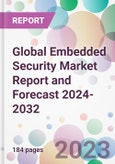According to the report, the global embedded security market is projected to grow at a CAGR of 6% between 2024 and 2032 reaching a value of approximate USD 12.04 billion by 2032. Aided by the surge in cyber threats, the increasing need to secure connected devices, and the consistent growth in IoT applications, the market is expected to grow significantly by 2032.
Embedded security pertains to a dedicated computer system with a purpose that covers both software and hardware, specifically designed to thwart threats and attacks against the host system. As the digital ecosystem continues to grow exponentially, ensuring the security and integrity of interconnected devices becomes paramount. This urgency is particularly prevalent in sectors such as finance, healthcare, defence, and consumer electronics, where data sensitivity and privacy concerns are at their peak.
A critical factor driving the embedded security market growth is the unprecedented growth of the Internet of Things (IoT) applications. As businesses and consumers become increasingly reliant on connected devices to simplify tasks and enhance efficiencies, these devices become potential vulnerabilities, offering points of entry for cyber threats. Ensuring that these devices remain uncompromised and authentic in their operation is where embedded security steps in, thus driving its market.
As per the embedded security market analysis, as the world moves more towards digital transactions, secure payment solutions have become the need of the hour. Embedded security, in this context, ensures the integrity of transactions, authenticates user identity, and protects sensitive financial data. With digital payments expected to rise, the role of embedded security in payment applications will undoubtedly intensify.
The automotive industry also offers fertile ground for the market's growth. With vehicles getting smarter, integrating advanced telematics, and connected technologies, they too, like any connected device, are susceptible to cyber threats which amplifies the embedded security market demand. Ensuring the security of vehicular systems, from infotainment to critical functions like braking and steering, is crucial, leading to the increased adoption of embedded security solutions in this sector.
Another dimension adding to the market's dynamics is the advent of advanced technologies like 5G. With faster connectivity and more devices getting connected, the need for robust embedded security solutions becomes even more critical which contributes to the embedded security market size.
Embedded security pertains to a dedicated computer system with a purpose that covers both software and hardware, specifically designed to thwart threats and attacks against the host system. As the digital ecosystem continues to grow exponentially, ensuring the security and integrity of interconnected devices becomes paramount. This urgency is particularly prevalent in sectors such as finance, healthcare, defence, and consumer electronics, where data sensitivity and privacy concerns are at their peak.
A critical factor driving the embedded security market growth is the unprecedented growth of the Internet of Things (IoT) applications. As businesses and consumers become increasingly reliant on connected devices to simplify tasks and enhance efficiencies, these devices become potential vulnerabilities, offering points of entry for cyber threats. Ensuring that these devices remain uncompromised and authentic in their operation is where embedded security steps in, thus driving its market.
As per the embedded security market analysis, as the world moves more towards digital transactions, secure payment solutions have become the need of the hour. Embedded security, in this context, ensures the integrity of transactions, authenticates user identity, and protects sensitive financial data. With digital payments expected to rise, the role of embedded security in payment applications will undoubtedly intensify.
The automotive industry also offers fertile ground for the market's growth. With vehicles getting smarter, integrating advanced telematics, and connected technologies, they too, like any connected device, are susceptible to cyber threats which amplifies the embedded security market demand. Ensuring the security of vehicular systems, from infotainment to critical functions like braking and steering, is crucial, leading to the increased adoption of embedded security solutions in this sector.
Another dimension adding to the market's dynamics is the advent of advanced technologies like 5G. With faster connectivity and more devices getting connected, the need for robust embedded security solutions becomes even more critical which contributes to the embedded security market size.
Market Segmentation
The market can be divided based on type, application, end use, and region.
Market Breakup by Type
- Hardware
- Software
- Service
Market Breakup by Application
- Payment
- Authentication
- Content Protection
- Others
Market Breakup by End Use
- Automotive
- Healthcare
- Consumer Electronics
- Telecommunications
- Aerospace and Defence
- Others
Market Breakup by Region
- North America
- Europe
- Asia Pacific
- Latin America
- Middle East and Africa
Competitive Landscape
The report looks into the market shares, plant turnarounds, capacities, investments, and mergers and acquisitions, among other major developments, of the leading companies operating in the global embedded security market. Some of the major players explored in the report are as follows:- NXP Semiconductors NV
- Infineon Technologies AG
- Microchip Technology Inc.
- STMicroelectronics
- Thales Group
- Samsung Electronics Co., Ltd.
- Others
Table of Contents
1 Preface2 Report Coverage - Key Segmentation and Scope4 Key Assumptions7 Industry Opportunities and Challenges12 Industry Events and Developments
3 Report Description
5 Executive Summary
6 Market Snapshot
8 Global Embedded Security Market Analysis
9 Regional Analysis
10 Market Dynamics
11 Competitive Landscape
List of Key Figures and Tables
Companies Mentioned
- NXP Semiconductors NV
- Infineon Technologies AG
- Microchip Technology Inc.
- STMicroelectronics
- Thales Group
- Samsung Electronics Co. Ltd.
Methodology

LOADING...







